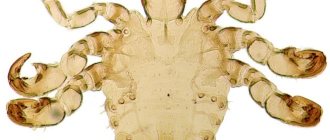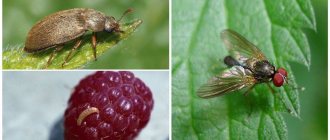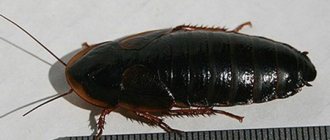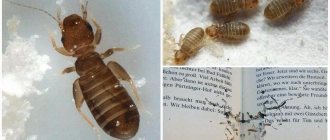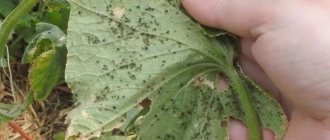Characteristic
As you can see in the photo, the raspberry, or stem, fly is a small insect with a pubescent body and a pair of transparent wings.
The dimensions are insignificant - the body length of an adult does not exceed 7 mm. The larva is a worm-like caterpillar, with a pale off-white body color, the size of which is about 5 mm. The larva has no legs; the mouthparts are located between the two anterior segments of the body. The adult caterpillar encloses itself in a barrel-shaped false cocoon that is brown in color. The parasites overwinter in this cocoon, usually in the top layer of soil. In May, when the substrate in the areas where the larvae are located warms up to +12…13°C, they pupate. Development in the pupa lasts about 7-9 days, after which adult flies emerge, whose years last from 8 to 10 days. In cold and rainy weather, the flight may take a little longer - up to 20 days. Under such conditions, most pupae die.
Emerging mature flies feed on flower nectar, dew and sugar secretions of other pest insects, after which the females lay eggs. They usually place eggs on the tops and in the axils of not yet formed leaves, young shoots and in the root shoots of raspberries.
The fertility of female raspberry stem flies is 60-90 eggs. Development in the egg takes from 5 to 8 days, after which the larvae emerge. Young growth bites into the middle of young stems and makes spiral and ring-like passages. The apical parts of damaged stems gradually wither, turn black and die over time. After 12-16 days, the larvae stop feeding. They gnaw through the stem and use the passages they make to descend into the soil for the winter. There they entangle themselves in a false cocoon and remain until spring.
On a note! The number of raspberry stem fly is limited by many predatory insects, especially ground beetles!
Reasons for appearance
There are several provoking factors that contribute to the appearance of stem flies in raspberries.
Among them:
- Close placement of blackberry, meadowsweet and meadowsweet plantings. These crops are also susceptible to stem fly attacks. And if raspberries are planted near them, sooner or later the raspberry fly moves to the neighboring area.
- Aphid. Untimely control of this pest can lead to the appearance of a stem fly, as it is attracted by copper dew. Ants contribute to the massive spread of aphids in the garden. Therefore, the fight must be waged against them.
- Lack of preventive treatments for bushes. In the spring, it is necessary to spray raspberries with insecticides during the period of swelling of the buds to prevent the appearance of pests.
- Poor quality humus and mulch. Pupated larvae can be found in organic fertilizer and peat. Using them, you can also introduce stem fly into the raspberry tree.
Important! This insect can appear in the garden if you purchase infected seedlings, so when purchasing, you need to pay attention to the turgor of the tops of young shoots.
The fly that loves raspberries
The raspberry stem fly is a pest of raspberry and blackberry bushes. To understand how it parasitizes plants, you need to know its life cycle. The flight and reproduction of these insects usually begins in the second half of May. An adult does not harm raspberry bushes: it does not eat them, does not gnaw them, and does not infect them with anything poisonous. The problem appears when the insect begins to lay eggs.
The raspberry stem fly places one white oval egg on the apical leaves of young shoots. One female can lay up to 90 pieces. And already at this moment the leaves begin to slowly fade. At this stage everything is fine in the lower part of the raspberry tree. A week later, a legless, cylindrical white larva emerges from the egg. The stems of young shoots are soft, so the larva penetrates under their skin without much difficulty. While feeding, it shreds the stem and gnaws through passages: first - straight down, ring-shaped - into the core, and then damages the base of the shoot.
Larvae feed on plant fiber in shoot cracks
It turns out that when last year's shoots bloom, the satiated larvae have already gone through the gnawed passage into the soil for the winter (in the form of a pupa). And in the spring the cycle repeats.
Table: what the raspberry stem fly looks like and where it lives
| Insect development stage | What does it look like | Where to find |
| Imago | Body size - 5-7 mm, gray-brown color, with black legs and a pair of transparent wings | On plants |
| Egg | Size - 3 mm, elongated oval shape, white color. | Axils of young, not yet formed leaves, upper shoots |
| Larva | Size - 5 mm. The caterpillar is off-white in color, without legs. The oral apparatus is located between the anterior segments. | Plant stems (internal space) |
| Doll | Size - 5–7 mm. Caterpillar in a barrel-shaped cocoon. Brown color. | Topsoil |
Photo gallery: appearance of the fly and signs of damage to the bushes
An adult raspberry fly lives on plant stems. Through a gnawed stem, the raspberry fly larvae go into the soil for the winter. The raspberry stem fly lays eggs on the tops of young shoots
Appearance of an insect
The raspberry stem fly is a small insect, about 6-7 mm long. Their color is brown-gray. The raspberry fly winters under bushes - in the upper layers of the soil. The active breeding season of the pest begins in the spring and occurs in April and May, depending on the regions of the country. This happens during the period when young shoots begin to appear. A raspberry fly crawls out of the ground.
To recognize the pest, you should carefully look at the photo of the raspberry stem fly. By itself, it is harmless; problems begin after it lays white, oval-shaped microscopic eggs. In total, a raspberry fly is capable of laying 90 of them. As soon as this happens, changes in the plant become noticeable - gradual withering of the leaves begins.
Insects lay eggs in the axils of the upper parts of the leaves. After 5-8 days, larvae are born, having a cylindrical shape and a white color. It is they, and not white flies on raspberries, as people often say, that cause significant damage to the bushes, gnawing helical passages in the soft stems. As a result, the bases of young shoots are damaged. Recognizing a raspberry fly is quite simple. If the young shoots in the upper part of the bush become sluggish and turn black, this means that a raspberry fly has appeared. There are passages visible along the stems, and if you cut them, you can see the larva itself. If no action is taken, the plant will die or the number of young shoots that are fruitful will be greatly reduced.
Important!
The raspberry stem fly can destroy not only raspberries, but also blackberries, meadowsweet and meadowsweet. To avoid mass destruction of bushes, you should fight by choosing truly effective methods and methods.
Raspberry fly
Description of the pest
The raspberry (stem) fly is a small (up to 7 mm) sized insect with transparent wings, a gray body and two brown spots on the sides of the head, reminiscent of eyes. Its larvae spend the winter in the soil at a depth of 6-7 cm. When the temperature here reaches +12-+13°C, they pupate and after 8-9 days turn into mature individuals that fly to the surface.
The period of mass flight and reproduction can vary depending on the weather: it usually lasts about a week, but in cool and rainy conditions it stretches to 20 days. In the regions of the middle zone, these processes usually occur by the end of April to mid-May. Raspberry flies feed on flower nectar, dew, and the sweet secretions of other insects.
What harm does
An adult stem fly does not pose a threat to raspberry bushes: it does not gnaw on them and is not a carrier of infections. The greatest harm occurs during the period of laying eggs, the number of which from one female reaches 60-90 pieces. They are located on the apical leaves of young shoots, which gradually begin to fade. After 8-9 days, larvae emerge from the eggs - gray-white worms about 5 mm in size. They penetrate the soft stems of plants, gnawing passages for themselves and reaching the base of the shoots. After 12-16 days, they turn into adult caterpillars, descend into the soil and entangle themselves in a barrel-shaped brown false cocoon, from which a new generation of insects will emerge next spring.
If a pest appears on the site, it is important not to miss the initial stage of the attack, otherwise you may lose most (up to 80%) of young healthy shoots. In remontant varieties, the formation of berries occurs on the fruit stems of the first year, therefore, in the event of a raspberry fly attack, the number of fruiting shoots will decrease significantly.
How to recognize
The first sign of damage is drooping of the tips of the shoots, as water and nutrients cease to flow to them. Later, the stems acquire a bluish tint, the leaves wither from top to bottom, the plants stop growing and dry out.
You can verify the presence of a pest by examining a cross section of the stem - passages appear in it, which the larvae make inside. When longitudinally dissected, the larva itself can be seen.
Favorable conditions for defeat
The following errors can contribute to the appearance of stem flies on raspberry bushes:
- Wrong neighborhood. Blackberries, meadowsweet, and meadowsweet are also susceptible to insect attack, so you should not place raspberries next to these crops, or near raspberries from neighboring areas.
- Thickening of plantings. It is important to periodically trim the bushes, since with high planting density, the task of digging up the surface layer of soil where the pest overwinters becomes more difficult.
- Problematic fertilizers. Infection can occur when humus is used as mulch, where insect larvae are located.
- Damage to aphids. The honeydew secreted by it can attract raspberry flies to raspberries. If you don’t take any measures to destroy the first one, you won’t have to wait long for the second one to appear.
- Lack of preventive spraying. They should be carried out in the spring when the buds are swelling, especially when there is a mass reproduction of insects due to favorable weather conditions.
Harm from the raspberry fly
If the upper part of young branches suddenly withers and turns black, and their growth stops, it means that the garden area is attacked by a stem fly. As is known, ordinary raspberry varieties begin to bear fruit on the branches of the second year, and in remontant varieties the fruits are laid on the fruit stems of the first year.
Therefore, raspberry yield indicators directly depend on the number of young shoots formed by the bush in the spring. It is easy to make sure that there is a parasite inside the branch; to do this, you need to examine its cross section: the larvae form burrows from top to bottom, along the entire branch.
If you cut it lengthwise, you can see the worm itself: a small white insect, up to 6 mm in size. In this way, by eating young shoots, raspberry flies are able to almost halve the number of fruitful branches.
Life cycle of the pest and signs of damage
The raspberry stem fly is a small insect with a brown-gray color. The length of the pest is 6-7 mm. It can damage not only raspberry bushes, but also blackberry bushes.
The pest becomes active in late spring. During this period, the fly begins to reproduce, laying eggs in the axils of the stems. Each time the insect produces one egg. This is manifested by withering of the shoot. However, not the entire stem withers, but only that part that is located above the laying site. Later, larvae emerge from the eggs. If you have time to remove the affected parts of the shoot, the bush will develop normally. The formation of larvae occurs within 5-8 days, which is determined by weather conditions. The higher the air temperature, the faster they develop.
The larvae are highly aggressive. They make moves in the stems, as a result of which the latter gradually wither and die over time. Upon closer inspection, bluish rings are visible on the branches. After 2-3 weeks, the larvae move into the ground. There they spend the entire cold period, and when warming turns into adults, after which the cycle repeats.
What methods to fight?
The raspberry fly should be fought before the female flies. If the larvae are allowed to hatch and begin feeding, young plants can die in just a few days.
Chemicals
To rid raspberries of stem flies, the following chemicals are used:
- Spark. It has the form of a tablet weighing 1 g, which is diluted in 10 liters. water. It is advisable to spray early in the morning or in the evening, in cool weather, so that the product lasts longer on the leaves.
- Karbofos. The effect is high, however, if the drug is used during the flowering period, it can kill the bees. The working solution is diluted immediately before treatments. Spraying is carried out at a temperature of at least +15 C, preferably in the evening. If the drug is applied before rain, there will be no effect.
- Actellik. An emulsion that affects the gastrointestinal tract of the pest. Sold in ampoules of 2 g or canisters, used before raspberries begin to bloom, because It also affects pollinators, such as bees.
When using chemicals, you should take care of your own protection. Protect your respiratory tract using personal protective equipment.
More gentle means for getting rid of raspberry stem fly are biological products that are not dangerous to beneficial insects.
- Agravertine. This is an alcohol tincture of soil fungus that can be stored for up to two years, but if diluted with water it must be used immediately. Spraying is carried out in warm, dry weather. The higher the temperature, the more effective the biological products work.
- Fitoverm. Destroys raspberry pests within a week. The last spraying is allowed no later than 2 days before harvesting the fruits.
Biological products do not pose a danger to bees and other pollinating insects.
Traditional methods
Folk remedies are loved by gardeners for their harmlessness, accessibility, and the effect from them can be no worse than from a newfangled chemical product. To combat stem fly on raspberries, use:
- Mustard powder solution. You will need 150-200 g of mustard per 8-10 liters. warm water.
- Tansy decoction. 250 grams of dry or fresh herbs, simmer in a water bath in 2 liters of water for 30 minutes. Dilute to 5 liters and immediately treat the bushes.
- Water infusion of garlic. 200 g of garlic are crushed and infused in 3 liters of warm water in a warm place for 3 days.
- Dandelion infusion. Leave approximately a kilogram of the plant, ground together with roots, in a bucket for 2-3 hours.
- Infusion of onion peel. Fill 1 volume of husk with 2 volumes of water. Leave for at least 2-3 days, otherwise the solution will be ineffective.
- Onion infusion. For 10-12 l. Hot water will require 1 kg. chopped onion. Stir, wait 2-3 hours and process the raspberries.
To improve adhesion and to make the solutions stay longer on the leaves and stems, crushed laundry soap is added to them. Spraying with folk remedies that are harmless to bees is also possible during the raspberry flowering period.
Infusions of tobacco and bird cherry leaves, as well as wormwood, are effective as pest repellents that are used in early spring, during the growing season.
If you carefully care for raspberry plantations, the likelihood of a raspberry fly attack is greatly reduced. At the first sign of the presence of a pest, action must be taken immediately. The use of dangerous insecticides is justified only if the raspberries are in a neglected state and are already severely affected by the pest, and preventive measures and folk remedies have not helped.
How to deal with raspberry fly
Methods for controlling raspberry stem fly
There are different methods that effectively help get rid of raspberry fly larvae.
Traps for raspberry flies
The fight will be more effective if you also hang traps for garden pests. In stores and departments for summer residents you can find various devices, for example:
- “Evil TED” from LETTO;
- flying insect killer GH1M;
- garden adhesive tape under various brands.
Read the instructions on how to use them. You can make your own traps. Hang plastic bottles with slotted windows on trellises among the raspberry bushes. Pour any sugar-containing liquid inside: fruit drink, beer, syrup, juice. It’s not scary if it ferments; the stronger the sweet smell, the more attractive it is to insects.
Insecticides
Chemicals are used both for preventive purposes and to combat flies. It is important to remember that insecticide treatment is carried out in calm weather, preferably in the morning or evening, when the sun is low. Treatment can be carried out during the day, but in cloudy weather. Such restrictions are necessary so that after treatment, sunburn does not form on fragile leaves. Of course, such preparations cannot be used before rain.
Working solutions of these products are used to treat leaves and stems against flies and the soil under bushes to destroy the larvae.
The following tools can be used for processing:
- Karbofos is a moderately toxic drug; for use, 60 g of the product is diluted in 1 bucket of water. You must be careful if there are beehives nearby, as the drug has a detrimental effect on bees;
- Iskra is a broad-spectrum drug, including against the raspberry fly. 1 tablet of the product is diluted in 10 liters of water;
- Atellik - sold in 2 ml ampoules and 5 liter canisters. Before diluting the product, you must follow the instructions for use. Due to the strong toxicity of the drug, it can be used no more than twice per season;
- Condifor is a highly effective, low-toxic product; when processed, it seeps through the surface of leaves, stems, and roots. Protects the plant from flies for two weeks, so repeated treatments are required.
- Fufanon-nova is an effective systemic insecticide. The solution is applied according to the instructions, 1 ampoule is diluted in 5.5 liters of water.
All insecticides are poisonous, so when working with them, you must be careful and wear protective clothing, goggles, and gloves.
Aggressive means
Chemicals are used during the period of shoot growth, when their height does not exceed a length of 15 mm. The most common drugs are the following:
- Karbofos. This is a moderately toxic substance. To prepare the required solution, dissolve 60 grams of the drug in 10 liters of water and spray the bushes with it in the evening. If the forecast is for rain, it is better not to use the drug. It is enough to treat the plant 2 times.
- Spark. It is a broad-spectrum product and helps well in the fight against insects that feast on leaves. The drug is sold in tablets. Prepare the solution according to the instructions on the package. One tablet is enough to prepare 10 liters of solution, which needs to be sprayed on raspberries.
- Actellik. A drug of chemical origin that has a negative effect on the gastrointestinal tract of the pest. It is sold in ampoules (2 g) in the form of an emulsion, as well as canisters containing 5 liters. The drug comes with instructions that describe in detail how to prepare and use the product. It is permissible to use the solution no more than twice a year, since the drug is quite toxic.
- Confidor. A highly effective, low-toxic insecticide that penetrates through the stem, foliage, and root of the plant. It provides excellent protection against raspberry flies for up to two weeks, even in very hot weather, and is practically not washed off by rain.
Important!
The preparations can only be used after picking the berries, as they are dangerous for bees and insects involved in the pollination process. It is also strictly forbidden to spray if there are beehives nearby.
Chemical methods of controlling raspberry stem fly
"Spark"
Insecticide against a wide range of pests, including effective against raspberry stem fly. It is supplied to the consumer in the form of a tablet weighing 1 g. To achieve the expected effect, spraying must be done with a solution freshly prepared according to the recipe indicated on the package. It should not be hot outside - it is better to carry out the activity in the evening or in cloudy, but not rainy weather. One tablet is enough to prepare 10 liters of liquid preparation that kills raspberry flies.
"Karbofos"
Moderately toxic pesticide against sap-sucking and leaf-eating pests. It is dangerous for bees, so the drug should not be used during the flowering period. The working fluid must be prepared immediately before spraying. The air temperature should not be lower than +15 C; this should be done in the evening. Mixing with other drugs is prohibited. Frequency of processing – 2 times. It is not recommended to use the product before rain.
"Aktellik"
A non-systemic organophosphorus insectoacaricide that affects the gastrointestinal tract of the pest. It is supplied to the retail network in concentrated form - 2-gram ampoules with emulsion or 5-liter canisters. Recipe for preparing the working mixture: the contents of the ampoule are diluted in 2 liters of water. Raspberries are processed with this composition. If the infection is serious, then the composition can be made more concentrated - 1 ampoule per 1 liter of water. Dangerous for bees - do not use during flowering.
"Confidor"
A low-toxic, highly effective insecticide characterized by systemic and contact action. The drug seeps through all parts of the plant - foliage, stem, root. It washes off very poorly and even in hot weather provides a high degree of protection for a period of 5 to 15 days. It is dangerous for bees, so spraying should be done in the evening or morning hours, when beneficial insects do not fly.
Biological drugs
To destroy raspberry flies, biological agents are used. Experts recommend paying attention to the following drugs:
- Fitoverm. It has a wide spectrum of action, but its effect will be noticeable only a week after use. You can treat the bushes with it several times in the evening, but no less than 2 days before harvesting. This product is safe for bees.
- Agravertine. The drug is an alcohol-infused extract from a soil fungus - streptomyces. The spraying solution is prepared according to the instructions. It should be used immediately. It is perfectly used in hot weather, enhancing the effect, but it is not recommended to use it at temperatures below 18 degrees.
Review
In June, I discovered that my raspberry bushes were badly damaged by raspberry flies. A neighbor recommended and gave me Fitoverm. She explained in detail how to use it. I did everything as expected and processed the raspberries in the evening. Good product, I recommend it.
Daria, Vladimir
Folk remedies
The raspberry fly is a specific insect. Preparations prepared by yourself have practically no effect on it. But gardeners and gardeners are not discouraged and are constantly looking for new measures to combat this pest, which can destroy the raspberry crop. In the comments, people write that they use Bordeaux mixture for this purpose. It is a mixture of copper sulfate and milk of lime. It is recommended to water the soil under the raspberry bushes with the resulting composition and problems such as raspberry flies will not arise.
Bordeaux mixture for raspberry fly
According to experts, this method is good if at the same time you use well-known drugs that have proven their effectiveness. Bordeaux mixture has been known to gardeners and gardeners for a long time. It is of great benefit when rot occurs; it helps perfectly with diseases of grapes, roses, and various shrubs. It is quite logical to assume that it is also good for raspberries. It definitely won't do any harm.
Review
I use Bordeaux liquid for roses all the time. 2 years ago I planted several raspberry bushes and also began to water this solution under them. So far I have not encountered any pests.
Galina, Minsk
Insecticidal preparations
Industrial preparations are used both for preventive purposes and to destroy emerging pests. It should be remembered that treatment with insecticidal agents is carried out when there is no wind, preferably before sunrise or in the evening when the sun sets. Spraying can be done in the daytime, but when it is cloudy.
These restrictions are necessary so that after spraying, burns from ultraviolet radiation do not appear on young leaves. Of course, such chemicals should not be used before rain. Working solutions of these insecticides are used to treat foliage and shoots against flies and soil under bushes. This will deal a fatal blow to the larvae.
Raspberries are processed when their growth reaches at least 15 mm. The following aggressive methods of control are most effective:
Kinmiks for pests
- Confidor. A low-toxic chemical that impregnates the stems, foliage and root system of shrubs. This is an effective insecticide, it is not washed off by precipitation and guarantees excellent protection against raspberry flies even in the heat. Effectiveness lasts about 15 days, then you need to repeat spraying.
- Spark. The drug has a wide spectrum of effects. It is used to spray leaves on which pests feed. Produced in tablet form. Prepare the working solution taking into account the manufacturer's instructions on the packaging of the chemical product. According to the instructions, one tablet is enough to prepare 12 liters of working solution. The raspberry bush is sprayed with it, the leaves and soil are generously moistened.
- Actellik. It is available for sale in the form of ampoules, suspensions, and also in tanks. How to make and use the solution is described in the manufacturer's instructions. Raspberry pest control is carried out no more than twice a year. The chemical has a high level of toxicity.
- Karbofos. It has a moderate level of toxicity. A bucket of water will require 60 g of product. Treat the bushes with the solution. Spraying is carried out in the evening hours when the air temperature drops. The frequency of spraying is about twice throughout the year.
- Fufanon-nova is an effective systemic insecticidal agent. For a solution according to the instructions, one ampoule is dissolved in 5.5 liters of clean water.
Important! The use of the above products is allowed strictly after harvesting. The drugs are dangerous for bees and insects that pollinate raspberries. Do not process if there are beehives in the immediate vicinity.
Means to combat raspberry fly
The sequence of measures to protect raspberries
Once the raspberry stem fly appears, it is necessary to fight it for a long time, both in spring and summer, and in autumn. The general plan of events is as follows:
- in early spring, as soon as the snow has melted, you should carefully dig up the entire area and thoroughly loosen the soil under the raspberry bushes;
- at the end of spring - around May, when the mass emergence of flies begins, if the drug allows (remember about the toxicity for pollinating insects), we treat with an insecticide;
- during the budding period, we cut out damaged stems and dispose of them immediately;
- in the fall, after harvesting, we again dig up the soil around the bushes, spill it with Bordeaux mixture and, if necessary, repeat the insecticidal treatment. During this period, it is better to use Karbofos.
Saving the harvest
If the damage to the raspberry tree is small, you can fight it by mechanically removing the shoots. It is important to remember here that the affected stem is removed to a healthy area, occasionally cutting at the root.
Why is it important? A raspberry shoot that is partially pruned will produce new fruit-bearing branches, and if you cut it at the base, this can cause the growth of basal shoots, which do not play a big role in the abundant fruiting of the raspberry bush.
If more than 50% of the young stems are destroyed, it is no longer possible to cope only by removing the affected branches; you need to fight the pest using strong insecticides or completely destroy the planting. Complete destruction makes sense when the raspberry tree is old (usually 10-12 years after planting).
In other cases, you need to try to save the berry garden; control in this case consists of a complex of treatment with insecticides and mechanical removal of the affected parts of the plants.
Ways to fight
Comprehensive care and timely treatment with various therapeutic and prophylactic agents are very effective measures in the fight against raspberry fly. Remember that spraying with any chemicals should be carried out in complete calm, in the morning or evening, as well as during the day in cloudy weather. This is necessary in order not to provoke the appearance of sunburn on fragile plants:
- For preventive spraying of raspberries, you can use a solution of any insecticide that effectively fights the adult and larval stages of insects. For example, by diluting a tablet of the drug “Iskra” in a bucket of water. This is done in early spring, at the stage of bud swelling;
- if the shoots are already more than half affected, the bushes are sprayed with a solution of Actellik, Fitoverm, Confidor or Kemifos according to the instructions, at the interval specified for each specific drug. This option is the least preferable; you may not have to eat raspberry jam this year, but the raspberries will be saved;
- if there is a large volume of affected raspberry stems, it is recommended to complete pest control in the fall: treatment with one of the above anti-fly preparations is carried out in August, after harvesting.
Folk methods of combating raspberry fly involve using means to increase the resistance of plants and strengthen their natural immunity. And this makes sense: pests more often and in greater numbers infect sick, depleted plants.
We fight the raspberry fly using folk methods:
- treating the soil around raspberry bushes with Bordeaux mixture prevents the appearance of pests such as raspberry flies and sawflies. To do this, you need to dilute the prepared powder in an amount of 100 grams per bucket of water and in the fall, when preparing the bushes for wintering, pour it on the tree trunks;
- spraying raspberries with an infusion of tobacco dust or laundry soap against aphids, which secrete honeydew and attract adult insects. A solution of tobacco dust to combat it is prepared as follows: take a bucket of warm water for 300-400 grams of dust and infuse the solution for 24 hours. Soap solution for aphids on raspberries: rub a piece of laundry soap into a bucket of warm water, after dissolving, add a glass of wood ash and spray the plants.
To maintain raspberry immunity and for preventive purposes, regular feeding, mulching and thinning of plants is necessary.
Prevention
As you can see, the raspberry fly is very dangerous, and the fight against it can take a long time. And in order to avoid troubles and prevent re-infection, it is necessary to act competently throughout the season. The quantity and quality of the harvest will depend on this.
Prevention is quite simple:
- regularly inspect the bushes in your raspberry patch and pay special attention to the condition of young shoots;
- if you know that there is definitely a raspberry fly in the neighboring area, then it would be useful to carry out preventive treatment with the drug “Karbofos” or “Actellik”;
- in spring and autumn, dig up the area and immediately collect all plant debris;
- Before winter, it is advisable to hill up all the bushes and cover the soil around them with mulch from compost or peat.
Remember, if you follow all precautions throughout the season, you can protect your raspberry tree from pest attack. And even if an infection occurs, do not give up, because now you know the methods of combating the raspberry stem fly. They are effective and easy to implement.
How to destroy a pest? We choose a drug.
It is necessary to begin the fight against raspberry stem fly with the simplest methods: inspecting the area and removing damaged shoots. It is advisable to do this during the budding period. We identify areas of shrubs damaged by the parasite and cut them off, capturing a few centimeters of the healthy part. All cut branches must be collected and burned outside the garden.
Insecticides
If the number of stem fly colonies is large, then insecticides should be used.
Important! It is advisable to carry out the first spraying with insecticides during the period of mass emergence of flies!
- "Spark". The drug is available in the form of tablets, which must be dissolved in a certain amount of water before use. To treat an area against raspberry flies, one tablet is dissolved in 10 liters of water and the bushes are sprayed with a fresh solution.
- "Karbofos". This drug works well against a wide range of leaf-eating garden pests. It is advisable to spray the working solution (60 g per 10 liters of water) in the evening at an air temperature of at least +15°C. You should fight the raspberry fly with this drug in the fall after harvesting, as it is toxic to bees and is prohibited for use during the flowering period.
- "Aktellik". Organophosphorus insectoacaricide of intestinal action, which is produced in liquid form and sold in ampoules of 2 ml and in canisters of 5 liters. The working solution is prepared from the contents of one ampoule diluted in two liters of water. In case of very severe infection, the concentration can be increased - the contents of one ampoule per liter of water. Like the previous drug, Actellik is toxic to bees, and therefore is not used during the flowering period.
- "Confidor". Systemic insecticide of contact action. When sprayed, the active ingredients of the drug penetrate the leaves and stems of the plant and spread throughout its entire body.
On a note! “Confidor” is resistant to washing off and works very effectively for 5-15 days even in the heat!
Important! Insecticide treatment alone will not be enough. In order to completely get rid of the pest, you need to carry out 2-3 sprayings!
How to care for raspberries: top simple rules
If the plant is strong and healthy, it will be able to resist pests and diseases. How to properly care for raspberries:
| Landing To prevent raspberry bushes from getting sick, you need to plant them correctly. The distance between rows should be at least 1.5 meters, and between bushes in a row - at least 70 cm. It is also important to choose good planting material so as not to bring diseases to the site along with it. |
| Trimming In spring, raspberries produce many useless shoots. To increase productivity, you need to trim unnecessary branches every year. In early spring, trim the trunk to a height of 1.5 m and leave no more than 7 large, strong and fruit-bearing branches, so the berries will be much sweeter |
| Loosening and weeding Pest eggs can overwinter in old weeds and underground, so it is important to periodically loosen the soil under the raspberries to a depth of 6 cm and weed out the weeds, this will destroy the pest eggs |
| Watering Raspberries do not like drought, but excess water causes even more harm to them. In summer and spring, raspberry bushes need to be watered as needed, when the ground is completely dry, but in the fall, on the contrary, they need to be heavily watered to prepare for winter. |
| Top dressing It is important to feed raspberries on time so that they grow strong. How to feed raspberries:
Do not use fresh manure for feeding, as it may cause fungal root diseases. At the beginning of summer, you can spray raspberries with Bordeaux mixture to avoid insects |
For more information on how to properly care for raspberries, watch the video:
Folk remedies and caring for raspberries
Proper and timely care of raspberries will prevent larvae from laying in the stems and will prevent larvae from developing in the soil. What is raspberry care?
- As soon as the first shoots begin to appear, inspect the raspberry tree once a week. When you see wilted young shoots, you must immediately cut them out and be sure to burn them. Cut the stem at ground level and even a little deeper into the ground;
- To repel flies, the bushes are irrigated with a solution of baking soda (2 tablespoons per bucket of water) and irrigated before the berries begin to set. For this purpose, someone sprays the bushes with mustard solution, which also helps;
- To prevent the raspberry fly from laying eggs, it is necessary that the larvae do not hatch into adults in the spring. For this purpose, mulching is carried out with a layer of at least 8 cm. Plant residues, peat, and sawdust are used as mulch;
- Remove old branches and young weak growth in a timely manner. They take on useful substances, the return from them will be minimal. The remaining young stems will take up more nutrients, grow stronger faster and cope better with pests and diseases. In addition, thickened raspberries are an ideal environment for flies;
- Treat raspberries in advance with biological preparations, they are harmless and effective, act on other pests, but are safe for bees;
- In the fall, after harvesting, collect fallen leaves, loosen the soil under the bushes; in loose soil, the pupae will freeze faster in winter. Loosen the soil carefully so as not to damage the root system. You can treat the soil with some insecticide.
Don’t forget to feed the bushes in the spring, then in the summer they will delight you with a bountiful harvest of sweet berries.
Reviews and advice from gardeners
It lasts for many years, but very weakly, so I simply cut off the dead stems. This year the attack was quite serious; in a week more than 1/2 of the young shoots died.
Sources
- https://beetlestop.ru/malinnaya-muha/
- https://zoolog.guru/drugaya-poleznaya-informacia/malinovaya-muha-borba-s-ney.html
- https://ofazende.ru/kak-borotsya-s-malinnoj-steblevoj-muhoj
- https://OgoOgorod.ru/sad/malina/malinovaya-muha.html
- https://rci76.ru/muhi-i-moshki/malinnaya-steblevaya-muha.html
- https://urozhajnayagryadka.ru/malinovaya-muha-foto-vred-posledstviya-kak-borot-sya/
- https://apest.ru/muhi/kak-izbavitsya-ot-muh/malinovaya-muha/
- https://jivovred.com/vsadu/malinovaya-muha-metody-borby
- https://vreditel-stoi.ru/sad/malina/malinnaya-muha.html
- https://qlumba.com/bolezni-rastenii/1227-vse-metody-borby-s-malinnoj-steblevoj-muhoj
- https://septik.guru/polezno-znat/malinovaya-muha-borba-s-ney.html
[collapse]

